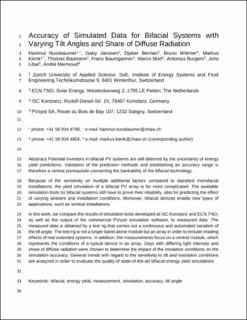Please use this identifier to cite or link to this item:
https://doi.org/10.21256/zhaw-19380Full metadata record
| DC Field | Value | Language |
|---|---|---|
| dc.contributor.author | Nussbaumer, Hartmut | - |
| dc.contributor.author | Janssen, Gaby | - |
| dc.contributor.author | Berrian, Djaber | - |
| dc.contributor.author | Wittmer, Bruno | - |
| dc.contributor.author | Klenk, Markus | - |
| dc.contributor.author | Baumann, Thomas | - |
| dc.contributor.author | Baumgartner, Franz | - |
| dc.contributor.author | Morf, Marco | - |
| dc.contributor.author | Burgers, Antonius | - |
| dc.contributor.author | Libal, Joris | - |
| dc.contributor.author | Mermoud, André | - |
| dc.date.accessioned | 2020-02-06T09:50:50Z | - |
| dc.date.available | 2020-02-06T09:50:50Z | - |
| dc.date.issued | 2020 | - |
| dc.identifier.issn | 0038-092X | de_CH |
| dc.identifier.issn | 1471-1257 | de_CH |
| dc.identifier.uri | https://digitalcollection.zhaw.ch/handle/11475/19380 | - |
| dc.description.abstract | Potential investors in bifacial PV systems are still deterred by the uncertainty of energy yield predictions. Validation of the prediction methods and establishing an accuracy range is therefore a central prerequisite concerning the bankability of the bifacial technology. Because of the sensitivity on multiple additional factors compared to standard monofacial installations, the yield simulation of a bifacial PV array is far more complicated. The available simulation tools for bifacial systems still have to prove their reliability, also for predicting the effect of varying ambient and installation conditions. Moreover, bifacial devices enable new types of applications, such as vertical installations. In this work, we compare the results of simulation tools developed at ISC Konstanz and ECN.TNO, as well as the output of the commercial PVsyst simulation software, to measured data. The measured data is obtained by a test rig that carries out a continuous and automated variation of the tilt angle. The test rig is not a single stand-alone module but an array in order to include shading effects of real extended systems. In addition, the measurements focus on a central module, which represents the conditions of a typical device in an array. Days with differing light intensity and share of diffuse radiation were chosen to determine the impact of the insolation conditions on the simulation accuracy. General trends with regard to the sensitivity to tilt and insolation conditions are analyzed in order to evaluate the quality of state-of-the-art bifacial energy yield simulations. | de_CH |
| dc.language.iso | en | de_CH |
| dc.publisher | Elsevier | de_CH |
| dc.relation.ispartof | Solar Energy | de_CH |
| dc.rights | http://creativecommons.org/licenses/by-nc-nd/4.0/ | de_CH |
| dc.subject | Bifacial | de_CH |
| dc.subject | Energy yield | de_CH |
| dc.subject | Measurement | de_CH |
| dc.subject | Simulation | de_CH |
| dc.subject | Accuracy | de_CH |
| dc.subject | Tilt angle | de_CH |
| dc.subject | PV | de_CH |
| dc.subject | Photovoltaics | de_CH |
| dc.subject.ddc | 621.3: Elektro-, Kommunikations-, Steuerungs- und Regelungstechnik | de_CH |
| dc.title | Accuracy of simulated data for bifacial systems with varying tilt angles and share of diffuse radiation | de_CH |
| dc.type | Beitrag in wissenschaftlicher Zeitschrift | de_CH |
| dcterms.type | Text | de_CH |
| zhaw.departement | School of Engineering | de_CH |
| zhaw.organisationalunit | Institut für Energiesysteme und Fluid-Engineering (IEFE) | de_CH |
| dc.identifier.doi | 10.1016/j.solener.2019.12.071 | de_CH |
| dc.identifier.doi | 10.21256/zhaw-19380 | - |
| zhaw.funding.eu | No | de_CH |
| zhaw.originated.zhaw | Yes | de_CH |
| zhaw.pages.end | 21 | de_CH |
| zhaw.pages.start | 6 | de_CH |
| zhaw.publication.status | acceptedVersion | de_CH |
| zhaw.volume | 197 | de_CH |
| zhaw.embargo.end | 2022-02-01 | de_CH |
| zhaw.publication.review | Peer review (Publikation) | de_CH |
| zhaw.webfeed | Photovoltaik | de_CH |
| zhaw.author.additional | No | de_CH |
| Appears in collections: | Publikationen School of Engineering | |
Files in This Item:
| File | Description | Size | Format | |
|---|---|---|---|---|
| 2019Klenk-etal_Accuracy of simulated data.pdf | Accepted Version | 1.13 MB | Adobe PDF |  View/Open |
Show simple item record
Nussbaumer, H., Janssen, G., Berrian, D., Wittmer, B., Klenk, M., Baumann, T., Baumgartner, F., Morf, M., Burgers, A., Libal, J., & Mermoud, A. (2020). Accuracy of simulated data for bifacial systems with varying tilt angles and share of diffuse radiation. Solar Energy, 197, 6–21. https://doi.org/10.1016/j.solener.2019.12.071
Nussbaumer, H. et al. (2020) ‘Accuracy of simulated data for bifacial systems with varying tilt angles and share of diffuse radiation’, Solar Energy, 197, pp. 6–21. Available at: https://doi.org/10.1016/j.solener.2019.12.071.
H. Nussbaumer et al., “Accuracy of simulated data for bifacial systems with varying tilt angles and share of diffuse radiation,” Solar Energy, vol. 197, pp. 6–21, 2020, doi: 10.1016/j.solener.2019.12.071.
NUSSBAUMER, Hartmut, Gaby JANSSEN, Djaber BERRIAN, Bruno WITTMER, Markus KLENK, Thomas BAUMANN, Franz BAUMGARTNER, Marco MORF, Antonius BURGERS, Joris LIBAL und André MERMOUD, 2020. Accuracy of simulated data for bifacial systems with varying tilt angles and share of diffuse radiation. Solar Energy. 2020. Bd. 197, S. 6–21. DOI 10.1016/j.solener.2019.12.071
Nussbaumer, Hartmut, Gaby Janssen, Djaber Berrian, Bruno Wittmer, Markus Klenk, Thomas Baumann, Franz Baumgartner, et al. 2020. “Accuracy of Simulated Data for Bifacial Systems with Varying Tilt Angles and Share of Diffuse Radiation.” Solar Energy 197: 6–21. https://doi.org/10.1016/j.solener.2019.12.071.
Nussbaumer, Hartmut, et al. “Accuracy of Simulated Data for Bifacial Systems with Varying Tilt Angles and Share of Diffuse Radiation.” Solar Energy, vol. 197, 2020, pp. 6–21, https://doi.org/10.1016/j.solener.2019.12.071.
Items in DSpace are protected by copyright, with all rights reserved, unless otherwise indicated.